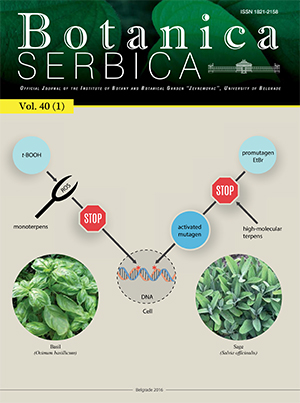
Volume 40 Issue 1 2016 |
Editorial
|
| |
Professor Dr. Draga Simic, On the occasion of her 80th birthday
|
| |
Alfalfa (Medicago sativa L.) and Sinorhizobium meliloti:prospects of using rhizobial inoculants in Serbia
|
KEY WORDS: alfalfa, Sinorhizobium meliloti, symbiotic nitrogen fixation, rhizobial inoculants |
Studying genotoxic and antimutagenic effects of plant extracts in Drosophila test systems
|
KEY WORDS: plant extracts, medicinal herbs, Drosophila, genotoxicity, antimutagenicity, diet |
Optimisation of the microdilution method for detection of minimum inhibitory concentration values in selected bacteria
|
The study was performed on four Gram-positive and four Gram-negative bacteria (ATCC collection) commonly used to investigate antimicrobial potential. The ratio between the optical density and number of bacteria in cultures was determined for each strain, and a strong linear correlation was detected. However, it was evident that different bacteria have different cell numbers at the same OD600 value. Based on the obtained results, inoculums for selected strains were prepared to obtain final cell numbers of 103, 104, 105 and 106 /well in the microdilution assay. Two different approaches were used in determining the MIC for rifampicin and streptomycin: approximation of MIC with IC90 and the resazurin reduction assay. Our results indicated that the ratio between optical density and cell numbers is not constant and use of the same OD for inoculums for all strains can therefore lead to misinterpretation of the MIC values. We also observed influence of cell numbers in inoculums in determination of MIC values. For both approaches used (approximation of MIC with IC90 and the resazurin reduction assay), the same trend was detected: antibiotics had the highest potency in experiments with the lowest bacteria cell number (103/well). The lowest cell number (103/well) is not recommended, as it can lead to false susceptibility results and to partial reduction of resazurin, which further complicates MIC determination. A final cell number of 104/well can therefore be recommended as optimal. KEY WORDS: MIC, minimum inhibitory concentration, antibacterial activity, microdilution, resazurin |
Antigenotoxic potential of plant monoterpenes linalool, myrcene and eucalyptol against IQ- and PhIP- induced DNA damage
|
KEY WORDS: monoterpenes, heterocyclic amines, DNA damage, comet assay, HepG2 cells |
Screening of the antibacterial effect of Juniperus sibirica
and Juniperus sabina essential oils in a microtitre plate-based MIC assay
|
KEY WORDS: Juniperus sibirica, Juniperus sabina, essential oils, MIC assay |
Determination of cyclodextrin production by cyclodextrin glycosyltransferase from alkalophilic Bacillus circulans strain B-65
|
KEY WORDS: cyclodextrins, cyclodextrin glycosyltransferase, Bacillus circulans |
Chemical characterization of essential oil from seeds of wild and cultivated carrots from Serbia
|
KEY WORDS: Daucus carota L. ssp. sativus (Hoffm.) Arcang., Daucus carota L. ssp. carota, GC/MS, sabinene, a-pinene, carotol |
Nomenclatural survey of the genus Amaranthus (Amaranthaceae). 4. Detailed questions arising around the name Amaranthus gracilis
|
KEY WORDS: Amaranthus viridis, Chenopodium acuminatum, Ch. caudatum, misapplication of names, N.J. Jacquin, typification |
Distribution of the genus Galanthus L. (Amaryllidaceae) in Serbia
|
KEY WORDS: Galanthus, Serbia, distribution, ecology, taxonomy |
Evidence from multivariate morphometric study of the Quercus pubescens complex in southeast Italy
|
KEY WORDS: fruit, genetic assignment, leaf, morphometric data, Quercus, statistical analysis, taxonomy |
Sphagnum fimbriatum, a species new for the flora of Serbia
|
KEY WORDS: Sphagnum fimbriatum, Mt. Ostrozub, Serbia |
Corrigenda to “Is it possible to identify Colchicum neapolitanum s.l. and C. autumnale s.l. in vegetative stage? Biometry and flow cytometry approaches”
[Botanica Serbica 38 (1): 43-56. 2014]
|
|


